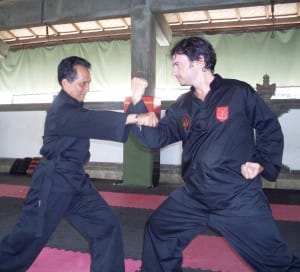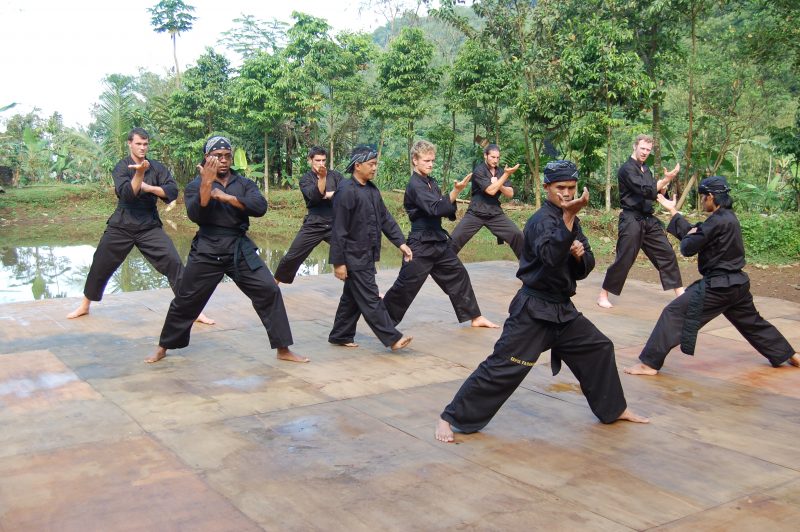Explore your inner self through the grace and beauty of a martial art so tightly woven into the fabric of local culture.
Indonesia, with its myriad of ethnicities and languages, has developed indigenous martial arts, with different variants in different regions. Pencak silat is one such artform: ‘pencak’ referring to the performance aspect, while ‘silat’ to the essence of fighting and self-defence – and for the practitioner, one cannot exist without the other.
The origins of this type of combat are lost in the mists of time, but a number of legends from the Sriwijaya Empire tell of a woman who witnessed a fight between a tiger and a large bird. She was so taken by the choreography of the fight, of the combatants’ movement in attack and defence. The legend says one night she was attacked by a group of drunken men, but she was able to fight them off using the skills she had observed from watching the big cat and the bird.
A similar tale exists around the archipelago. The Sundanese people of West Java believe the woman witnessed a monkey and a tiger on the remote island of Bowan, north of Madura.
Pencak silat spread around the islands, as traders and seafarers moved from Sumatra to Java to Sulawesi and back again, and as time went on the sport took root in different soils. Locals added elements of their own cultures to give the different regional variations we see today.
For all the differences at its heart, pencak silat focuses on strikes, joint manipulation, throws and bladed weaponry and has become an internationally recognised sport.


Anthropologist and one-time member of the Australian pencak silat team, Ian Douglas Wilson, sums it up as “a form of traditional education, a performance art, a component of ritual and community celebrations, a practical form of self-defence, a path to spiritual enlightenment, and more recently, as a national and international sport; pencak silat is in many respects unique.”
“The philosophy of pencak silat is contained within movement. This philosophy can be at the level of a self-defence strategy, but it can also be used in the everyday as a method for living an ethical life,” says Yosis Siswoyo, the head of the Bandarkarima Pencak Silat School.
“For example, there are Suliweh steps and Jurus steps,” Siswoyo continues. Jurus means honest and straight. “This means you must move on and on, straight to the point without any improvisation.” Suliweh means moving to the side so an opponent can pass, and you can keep moving.
During his time in Indonesia, Wilson spent several years studying and practising pencak silat, and based upon his research in West Java, identifies a number of different strains:
BANDRONG
Local to the Banten region and heavily influenced by Sumatran pencak silat.
BENJANG
A form of wrestling originating from the Ujung Berung district of Bandung. Elements of Benjang have influenced West Javanese pencak silat.
CIGONDEWAH
Developed by Mama Marzuki from the Cigondewah village, Bandung, that combines elements of Kari, Madi and Syahbandar pencak silat. In modern times the style has integrated spiritualist practices involving ritual supplications and séances at Mama Marzuki’s grave.
CIKALONG
From the Cikalong district of Cianjur, this style was developed by the aristocrat Raden Haji Ibrahim (1816–1906) after studying under a number of teachers, including Bang Kari and Bang Madi. One of the most influential styles in West Java, it places an emphasis upon the development of heightened sensitivity in the hands and forearms in order to read and counter an opponent’s moves.
CIKARET
A style incorporating elements of Cikalong and Cimande developed by Haji Ahmad Sanusi, a student of Raden Haji Ibrahim. Haji Sanusi established a pesantren (Islamic boarding school) in the Cikaret area of Sukaraja, West Java, during the late 19th century, where pencak silat training was combined with religious learning.
CIMACAN
Also known as silat maung, this style simulates the movements of a tiger. Reputed to originate from the Mount Gede region near Bogor, the practitioner can embody the spirit of a tiger.
CIMANDE
From the Cimande district of Bogor, reputedly first developed and spread by Abah Kahir in the late 18th and early 19th century. Generally considered to be the oldest and most influential style in West Java. Focuses upon arm-based counter-offensive techniques as well as dance known as ibing penca.
JALAKRAWI
From the Banten region, this style — in contrast to the majority of West Javanese styles — focuses upon kicks and other leg movements possibly due to Sumatran influence.
KARI
Named after Bang Kari, a pencak silat master reputedly from Jambi, who moved to Jakarta around the end of the 19th century. Kari is a hard and aggressive style that emphasizes fast combinations of offensive movements.
KUNTULAN
Style from the town of Cirebon on the north coast of West Java.
MADI
Named after Bang Madi, a native of Jakarta in the late 19th century. A horse trader by trade, Bang Madi was renowned for his close-range fighting skills, and his ability to follow and anticipate an opponent’s movements.
NAMPON
Developed in Bandung by Uwa Nampon in the 1930s, this style combines pencak silat movements with breathing techniques to develop inner power, referred to as spierkracht.
SANALIKA
Cikalong and Syahbandar derived style, developed by the Cianjur aristocrat Raden Utuk Sumadipraja and formally established as a pencak silat school in 1926.

Developed by Wah Sera, reputed to be a student of the Cimande master Abah Kahir. Most prevalent in the Bogor region and Jakarta.
SYAHBANDAR
Developed by Mama Kosim (1776–1880) a native of Jambi in South Sumatra who moved to Purwakarta in West Java, becoming a student of the Sufi teacher Ajengan Cirata. Syahbandar technique is renowned for its soft evasive movements.
TAJIMALELA
Developed in Bandung in the early 1970s by Raden Djadjat Kusumadinata. A new style not tracing links to any existing pencak silat lineage. Initially focused purely on self-defence, it has been adapted with great success to the sporting competition forum.
TERUMBU
From the Banten region, reputed to have been developed in the 17th century, making it one of the oldest styles in West Java.
TIMBANGAN
Style technically and philosophically similar to the Japanese martial art Aikido, developed by Raden Anggakusumah in Bandung in the 1930s. Without kicks, punches or other offensive techniques, the style involves using an opponent’s energy against them.
ULIN MAKAO
A mixture of Chinese and West Javanese styles, developed in Pandeglang, Banten. First taught by Ki Abu Arwanta in the late 19th century, who combined techniques learnt from a Macao martial artist whom he defeated in a challenge.
—
How to Get Involved
The body that oversees Pencak Silat in Indonesia – the home page has been hacked and the site outdated.
http://forumsilat.blogspot.com/p/tempat-latihan-silat-di-jakarta.html
List of places to train in Jakarta.
A pencak silat camp in Denpasar, Bali, open to all who wish to learn the martial art.
Alternatively, the South East Asian Games takes place in Singapore at the end of this month with Indonesia taking on its rivals in ASEAN for bragging rights. In the 2013 SEA Games in Myanmar, Indonesia topped the pencak silat medal table, lifting 11 in total, including four golds. For the really keen it may offer an opportunity to meet and greet people actively involved in the sport.




